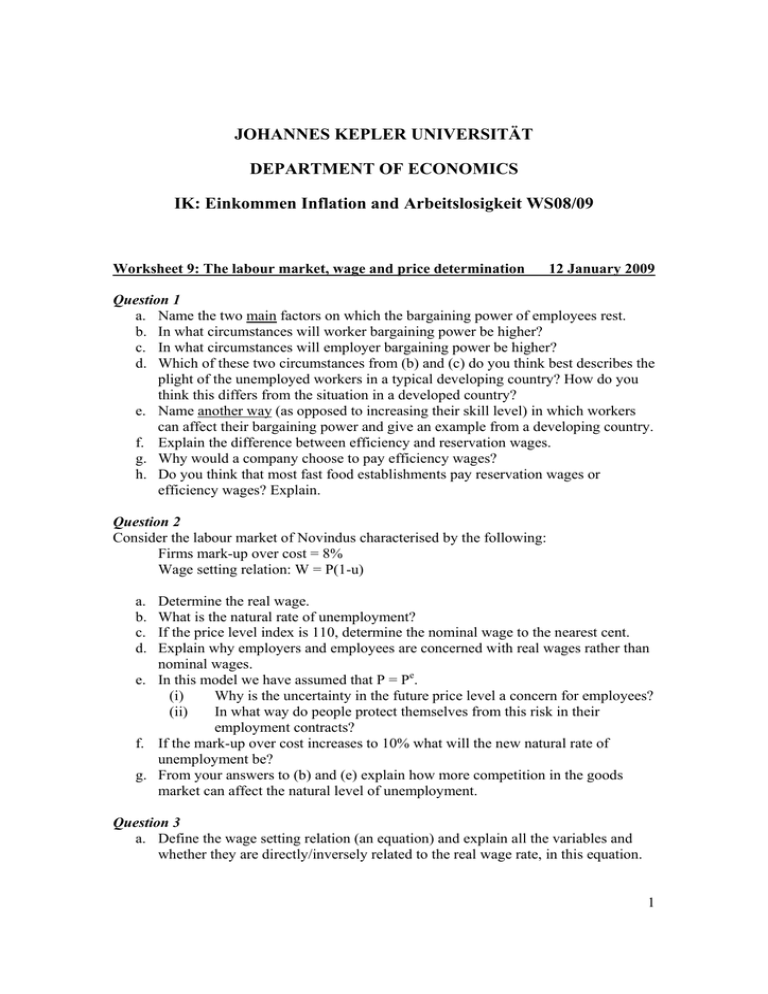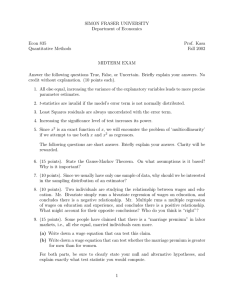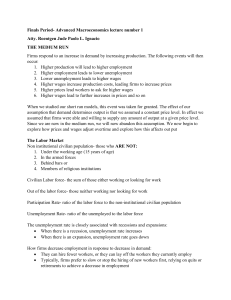JOHANNES KEPLER UNIVERSITÄT
advertisement

JOHANNES KEPLER UNIVERSITÄT DEPARTMENT OF ECONOMICS IK: Einkommen Inflation and Arbeitslosigkeit WS08/09 Worksheet 9: The labour market, wage and price determination 12 January 2009 Question 1 a. Name the two main factors on which the bargaining power of employees rest. b. In what circumstances will worker bargaining power be higher? c. In what circumstances will employer bargaining power be higher? d. Which of these two circumstances from (b) and (c) do you think best describes the plight of the unemployed workers in a typical developing country? How do you think this differs from the situation in a developed country? e. Name another way (as opposed to increasing their skill level) in which workers can affect their bargaining power and give an example from a developing country. f. Explain the difference between efficiency and reservation wages. g. Why would a company choose to pay efficiency wages? h. Do you think that most fast food establishments pay reservation wages or efficiency wages? Explain. Question 2 Consider the labour market of Novindus characterised by the following: Firms mark-up over cost = 8% Wage setting relation: W = P(1-u) a. b. c. d. Determine the real wage. What is the natural rate of unemployment? If the price level index is 110, determine the nominal wage to the nearest cent. Explain why employers and employees are concerned with real wages rather than nominal wages. e. In this model we have assumed that P = Pe. (i) Why is the uncertainty in the future price level a concern for employees? (ii) In what way do people protect themselves from this risk in their employment contracts? f. If the mark-up over cost increases to 10% what will the new natural rate of unemployment be? g. From your answers to (b) and (e) explain how more competition in the goods market can affect the natural level of unemployment. Question 3 a. Define the wage setting relation (an equation) and explain all the variables and whether they are directly/inversely related to the real wage rate, in this equation. 1 b. Define the price setting relation (an equation) and explain all the variables and whether they are directly/inversely related to the real wage rate, in this equation. c. Given z held constant what is the relationship between unemployment and the real wage? d. Give an example of a situation that would be captured in the model through an increase in z. e. In (d), is the increase in z related to an increase or decrease in employee bargaining power? f. Given all things held equal and using this model only, will the increase in z have a positive or negative result on worker welfare? g. In reality we know that living standards have certainly risen over time (think about medicine, nutrition, electricity…). Surely real wages have thus risen over time… (i) Using this model, how can real wages rise in equilibrium? (ii) Does this account for the rise in living standards over time? What have we excluded and how has it been removed from the model? h. Explain the concept of the natural level of employment and the natural level of output. Over what time period do we assume that the economy returns to the natural level of output? i. How can the natural level of output change? Question 4 a. With the support of an appropriate diagram explain how the following situations may affect real wages and the natural rate of unemployment. Make sure that you explain the economic rationale behind the changes. If you feel that real wages and the natural rate of unemployment will be unaffected you must justify this view. (i) An increase in unemployment benefits (ii) An increase in the mark-up on cost (iii) Greater legal protection of employed workers makes the process of replacing workers more onerous (iv) Trade union leadership becomes so divided that it splits into two opposing parts (v) The government increases the minimum wage that can legally be paid to workers b. What assumptions have we made in this model to get to the production function Y = N. c. What assumption have we made in this model regarding the returns to labour? Hint: read the appendix of the chapter. 2



